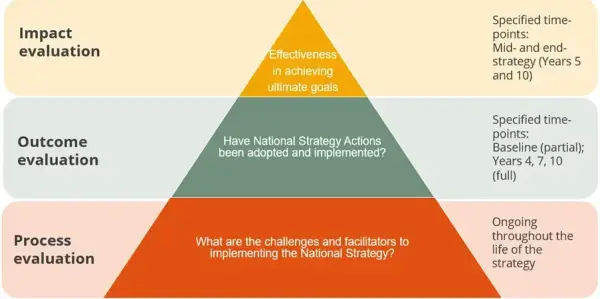NEDC has developed a multi-level Evaluation Framework for the Implementation of the National Strategy (Evaluation Framework) to guide evaluation of the implementation of the Strategy, including its process, outcomes and impact. The Evaluation Framework is underpinned by the RE-AIM (Reach, Effectiveness, Adoption, Implementation and Maintenance) Framework for evaluating implementation outcomes, and draws on key implementation evaluation principles (for example Proctor et al., 2011). The Evaluation Framework will guide NEDC’s approach to evaluating the implementation of the National Strategy over the ten-year period.
The term “evaluation” encompasses different types, each serving a different function. For assessing the implementation of the National Strategy, NEDC have selected three key evaluation types: process evaluation, outcome evaluation, and impact evaluation. Each has a distinct purpose, however the information and insights gained from one type will enrich our understanding of the others. A description and overview of these evaluation types is provided below and in Figure 1, followed by a high-level for the different types of evaluation which will be
conducted, aligned with the implementation phases of National Strategy timeline.

Helping you to evaluate your programs and services
The Evaluation Framework focuses on NEDC’s overarching approach to evaluating the implementation of the National Strategy. Individual stakeholders are encouraged to utilise evaluation within their own initiatives to continuously inform and improve services and service user outcomes.
An evaluation resource has been developed by NEDC to support implementation of the National Strategy. You can access the resource here.
This evaluation tool has been developed for service leaders, commissioners of services, implementers and local champions. It provides a menu of options for identifying progress indicators, setting outcome goals and measuring the impact and effectiveness of service/program changes implemented based on the standards and actions outlined within the National Eating Disorders Strategy.
Example high-level progress indicators are outlined below, which can be used to develop specific outcome measures (both qualitative and quantitative) and help evaluate progress towards the standards and actions.
Prevention
• Population-level disordered eating rates are reduced.
• Population-level body dissatisfaction is reduced.
• Population-level eating disorder rates are reduced.
• Experience and impacts of weight stigma and associated health care inequity are reduced.
• Levels of knowledge about eating disorders in the general population are improved.
• Body acceptance and positive relationships with food and eating are increased.
Identification
• A higher proportion of eating disorders are identified.
• Eating disorders are identified earlier in illness or sub-threshold illness.
• People report improved help-seeking experiences.
Initial Response
• There is increased availability of initial eating disorder assessment and referral in health and mental health services.
• The time between identification and initial response is reduced.
Treatment
• Eating disorder recovery outcomes are improved.
• The time between initial response and treatment commencement is reduced.
• Access to short term evidence-based interventions is increased.
• Increased number of people receive care in the community.
• People with an eating disorder report a ‘no wrong door’ experience to treatment-seeking and service navigation.
• Hospital admission and readmission rates are reduced.
• More people receive care of their eating disorder within public mental health settings.
Psychosocial & Recovery Support
• Psychosocial support services and programs provide more services for people experiencing eating disorders.
• People can access recovery support services during the recovery journey.
Workforce
• There is increased availability of a skilled and diverse workforce across the system of care.
• The workforce is confident and willing to provide care to people experiencing or at risk of eating disorders.

